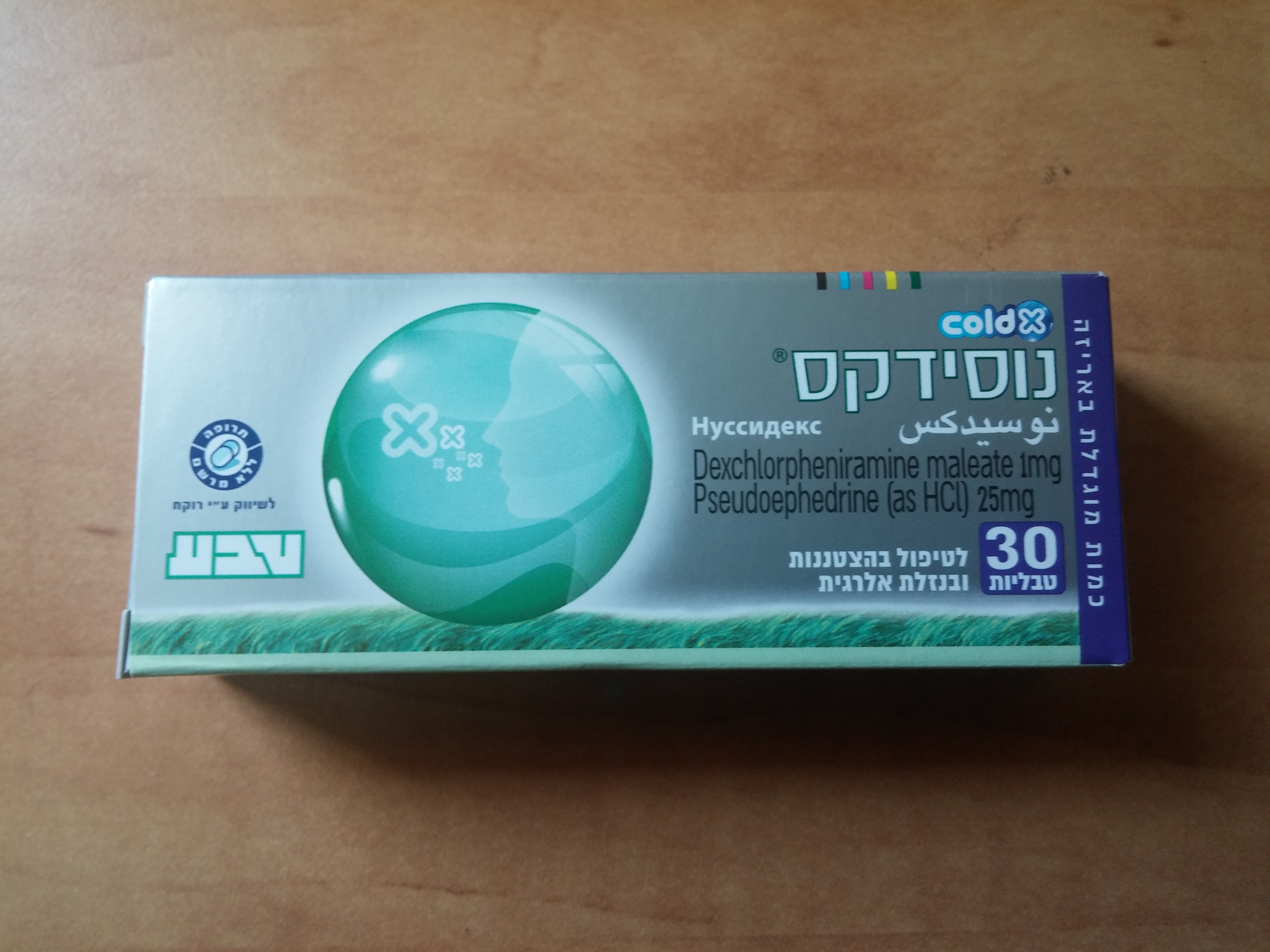Quest for the right Drug

נוסידקס NUSSIDEX (DEXCHLORPHENIRAMINE MALEATE, PSEUDOEPHEDRINE AS HYDROCHLORIDE)
תרופה במרשם
תרופה בסל
נרקוטיקה
ציטוטוקסיקה
צורת מתן:
פומי : PER OS
צורת מינון:
טבליה : TABLETS
עלון לרופא
מינוניםPosology התוויות
Indications תופעות לוואי
Adverse reactions התוויות נגד
Contraindications אינטראקציות
Interactions מינון יתר
Overdose הריון/הנקה
Pregnancy & Lactation אוכלוסיות מיוחדות
Special populations תכונות פרמקולוגיות
Pharmacological properties מידע רוקחי
Pharmaceutical particulars אזהרת שימוש
Special Warning עלון לרופא
Physicians Leaflet
Adverse reactions : תופעות לוואי
4.8 Undesirable Effects Adverse reactions attributed to the antihistamine component (dexchlorpheniramine maleate) Slight to moderate drowsiness is the most frequent side effect of dexchlorpheniramine maleate. Other reported reactions associated with antihistamine therapy in general include: General: Urticaria, drug rash, anaphylactic shock, photosensitivity, excessive perspiration, chills, dryness of mouth, nose and throat Cardiovascular: Hypotension, hypertension, headache, palpitations, tachycardia, extrasystoles Haematological: Haemolytic anaemia, hypoplastic anaemia, thrombocytopenia, agranulocytosis Gastrointestinal: Epigastric distress, anorexia, nausea, vomiting, diarrhoea, constipation Genitourinary: Urinary frequency, difficult urination, urinary hesitation and retention, early menses Nervous System: Sedation, dizziness, disturbed coordination, fatigue, confusion, restlessness, excitation, nervousness, tremor, irritability, insomnia, euphoria, paraesthesia, blurred vision, diplopia, vertigo, tinnitus, acute labyrinthitis, hysteria, neuritis, convulsions, lassitude, depression, inability to concentrate, dilated pupils, hypereflexia, hyporeflexia, xerostomia, hallucinations, appetite stimulation, anxiety, facial dyskinesias and seizures Respiratory: Thickening of bronchial secretions, tightness of chest, wheezing, nasal stuffiness Adverser Reactions attributed to pseudoepehdrine component Adverse drug reactions (ADRs) identified during clinical trials and post-marketing experience with pseudoephedrine are listed below by System Organ Class (SOC). The frequencies are defined according, to the following convention: Very common ≥1/10 Common ≥1/100 and < 1/10 Uncommon ≥1/1,000 and <1/100 Rare ≥1/10,000 and <1/1,000 Very rare <1/10,000 Not known (cannot be estimated from the available data) ADRs are presented by frequency category based on 1) incidence in adequately designed clinical trials or epidemiology studies, if available, or 2) when incidence cannot be estimated, frequency category is listed as 'Not known'. System Organ Class (SOC) Frequency Adverse Drug Reaction (Preferred Term) Blood and lymphatic system Not known Blood disorders, blood dyscrasias (including disorders agranulocytosis and thrombocytopenia) have been reported following paracetamol use but were not necessarily causally related to the drug Immune System Disorders Rare Hypersensitivity (cross-sensitivity may occur with other sympathomimetics) Psychiatric Disorders Common Insomnia Nervousness Not known Anxiety Euphoric mood Excitability Hallucination Irritability Paranoid delusions Restlessness Sleep disorder Nervous System Disorders Very Headache common Common Dizziness Not known Cerebrovascular accident Paraesthesia Posterior reversible encephalopathy syndrome (PRES) / Reversible cerebral vasoconstriction syndrome (RCVS) Psychomotor hyperactivity Somnolence Tremor Eye Disorders Not known Ischaemic optic neuropathy Cardiac Disorders Not known Dysrhythmias Myocardial infarction/Myocardial ischaemia Palpitations Tachycardia Vascular Disorders Not known Hypertension Gastrointestinal Disorders Common Dry mouth Nausea Not known Abdominal pain Diarrhoea Ischaemic colitis Vomiting Hepatobiliary disorders Rare Hepatic necrosis Skin and Subcutaneous Not known Angioedema Tissue Disorders Fixed eruption Pruritus Rash pruritic Severe skin reactions, including acute generalised exanthematous pustulosis (AGEP) Urticaria Rare Rash Renal and Urinary Uncommon Nephropathy toxic Disorders Not known Dysuria Renal papillary necrosis (after prolonged administration)Urinary retention (in men - prostatic enlargement could have been an important predisposing factor) Reporting of suspected adverse reactions Reporting suspected adverse reactions after authorisation of the medicinal product is important. It allows continued monitoring of the benefit/risk balance of the medicinal product. Any suspected adverse events should be reported to the Ministry of Health according to the National Regulation by using an online form https://sideeffects.health.gov.il

שימוש לפי פנקס קופ''ח כללית 1994
Symptomatic treatment of common cold, allergic & vasomotor rhinits, hay fever
תאריך הכללה מקורי בסל
01/01/1995
הגבלות
תרופה שאושרה לשימוש כללי בקופ'ח
מידע נוסף
עלון מידע לצרכן
31.10.16 - עלון לצרכן 10.05.23 - עלון לצרכן עברית 21.08.23 - עלון לצרכן אנגלית 21.08.23 - עלון לצרכן עברית 21.08.23 - עלון לצרכן ערבית 29.01.24 - עלון לצרכן עברית 12.02.24 - עלון לצרכן אנגלית 12.02.24 - עלון לצרכן עברית 12.02.24 - עלון לצרכן ערבית 19.03.24 - עלון לצרכן עברית 13.05.24 - עלון לצרכן אנגלית 13.05.24 - עלון לצרכן עברית 13.05.24 - עלון לצרכן ערבית 31.07.24 - עלון לצרכן עברית 20.09.24 - עלון לצרכן אנגלית 20.09.24 - עלון לצרכן ערבית 26.09.24 - עלון לצרכן עברית 10.05.23 - החמרה לעלון 28.12.23 - החמרה לעלון 29.01.24 - החמרה לעלון 19.03.24 - החמרה לעלון 31.07.24 - החמרה לעלוןלתרופה במאגר משרד הבריאות
נוסידקס